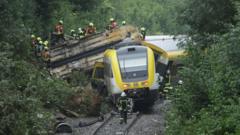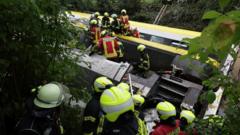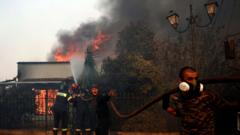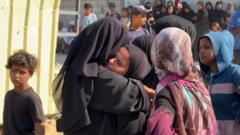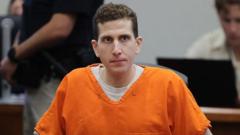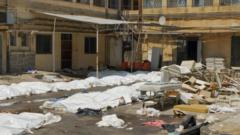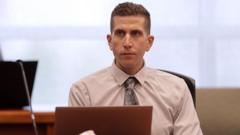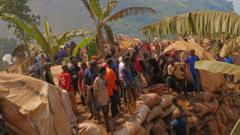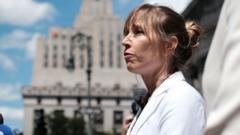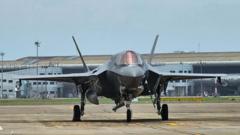In a shocking incident, a Bangladesh Air Force fighter jet crashed into a primary school in Dhaka, resulting in a high death toll, including numerous young students.
Tragedy Strikes Dhaka: Fighter Jet Crash Claims Lives at Primary School
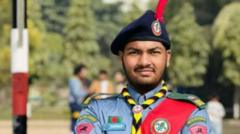
Tragedy Strikes Dhaka: Fighter Jet Crash Claims Lives at Primary School
A devastating fighter jet crash in Dhaka leaves many schoolchildren dead and the community in turmoil.
On Monday, chaos reigned in the busy Uttara neighborhood as an F-7 fighter jet from the Bangladesh Air Force plunged into the Milestone School and College, marking one of the nation's most tragic aviation disasters. Witnesses, including students who were nearby, described the overwhelming sound of the crash as thunderous and earth-shattering. The tragic event left at least 31 people dead, many of whom were young schoolchildren awaiting rides or snacks.
Ahnaf Bin Hasan, an 18-year-old student, shared his harrowing experience, still haunted by memories of the incident. "It was like 30 or 40 thunderbolts," he recalled, as he witnessed the jet crash just 30 feet away from him. Despite the chaos, Ahnaf quickly leaped into action, helping injured classmates escape the flames.
The pilot of the jet ejected moments before impact, later dying in the hospital despite surviving the initial crash. Eyewitnesses highlighted the catastrophic scene that unfolded: children screaming, thick smoke billowing into the air, and the devastation left in the wake of the accident as responders rushed to aid the victims. One particularly heartbreaking account came from Wakia Firdous Nidhi’s family. She was one of the schoolchildren killed during the incident, and her family's ongoing struggle for closure has been compounded by bureaucratic hurdles surrounding the release of her body.
In the aftermath of the tragedy, numerous stories have emerged that reveal both profound acts of bravery and unimaginable loss. One mother shared how her child was spared from disaster by a last-minute decision not to pack lunch, illustrating how luck played a role in survival. Conversely, a father faced the unbearable pain of losing both of his children on the same day, the shocking reality of life and death in traumatic circumstances.
Risking her own life, teacher Mahreen Chowdhury saved countless students during the chaos, ultimately leading to her own demise as she continued to rush back into the burning building. The outpouring of grief from the school community paints a picture of devastating loss—educators lament the lives and futures stolen from them in an instant. Reports of missing children and discrepancies in casualty figures have further fueled public concern and speculation regarding the authorities' handling of the incident.
Many survivors are struggling with the psychological aftermath, as Ahnaf describes the persistent nightmares and memories that plague him. The airspace around the school frequently saw planes flying overhead, but now, that familiarity carries an ominous reminder of the horrors of that day, with survivors constantly looking to the sky in fearful anticipation.
Voices of bereaved families and the community reinforce the call for answers and accountability from both the military and governmental authorities for the tragic loss of life and the devastation inflicted upon a once lively school environment.
Ahnaf Bin Hasan, an 18-year-old student, shared his harrowing experience, still haunted by memories of the incident. "It was like 30 or 40 thunderbolts," he recalled, as he witnessed the jet crash just 30 feet away from him. Despite the chaos, Ahnaf quickly leaped into action, helping injured classmates escape the flames.
The pilot of the jet ejected moments before impact, later dying in the hospital despite surviving the initial crash. Eyewitnesses highlighted the catastrophic scene that unfolded: children screaming, thick smoke billowing into the air, and the devastation left in the wake of the accident as responders rushed to aid the victims. One particularly heartbreaking account came from Wakia Firdous Nidhi’s family. She was one of the schoolchildren killed during the incident, and her family's ongoing struggle for closure has been compounded by bureaucratic hurdles surrounding the release of her body.
In the aftermath of the tragedy, numerous stories have emerged that reveal both profound acts of bravery and unimaginable loss. One mother shared how her child was spared from disaster by a last-minute decision not to pack lunch, illustrating how luck played a role in survival. Conversely, a father faced the unbearable pain of losing both of his children on the same day, the shocking reality of life and death in traumatic circumstances.
Risking her own life, teacher Mahreen Chowdhury saved countless students during the chaos, ultimately leading to her own demise as she continued to rush back into the burning building. The outpouring of grief from the school community paints a picture of devastating loss—educators lament the lives and futures stolen from them in an instant. Reports of missing children and discrepancies in casualty figures have further fueled public concern and speculation regarding the authorities' handling of the incident.
Many survivors are struggling with the psychological aftermath, as Ahnaf describes the persistent nightmares and memories that plague him. The airspace around the school frequently saw planes flying overhead, but now, that familiarity carries an ominous reminder of the horrors of that day, with survivors constantly looking to the sky in fearful anticipation.
Voices of bereaved families and the community reinforce the call for answers and accountability from both the military and governmental authorities for the tragic loss of life and the devastation inflicted upon a once lively school environment.

